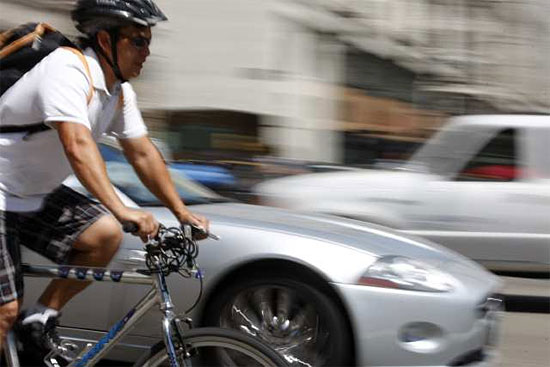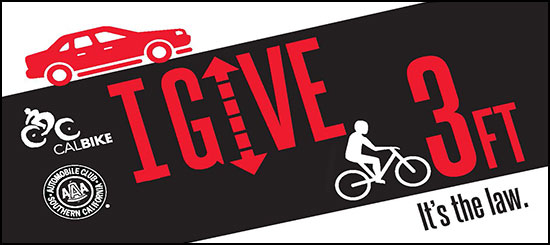Give ‘em three—or face a fine
August 27, 2014
As a frequent bicycle commuter in Los Angeles, Nathan Lucero is used to blaring car horns and close encounters with vehicles whizzing by.
“I’ve had plenty of close calls. I actually got honked at this morning….they buzzed me on the left side,” says the 32-year-old industrial designer, who lives in Eagle Rock and rides his bike a couple of times a week to his job in the South Park area of downtown L.A. “Then I got buzzed by a little Mini two minutes later.”
Lucero, who has taken to wearing a helmet camera to capture such encounters, says he is thinking about editing his footage into an educational video.
His timing couldn’t be better. On September 16, the so-called “Three Feet for Safety Act” goes into effect in California, specifying for the first time a state standard for safely passing bicycles.
As cycling becomes more popular in Los Angeles and around the state, sharing the streets has never been more important. The new law, championed by state Assemblyman Steven Bradford of Gardena and signed by Gov. Jerry Brown last year, is part of a broader movement, including the “Give Me 3″ campaign launched in the Los Angeles in 2010, and is intended to literally spell out the rules of the road for the first time.
The measure requires motorists to pass bicyclists by at least three feet, or, if that’s not possible, to slow down until there is an opportunity to pass safely. Violators face a $35 fine, which goes up to $220 if a driver passing unsafely collides with and injures a bicyclist.
Lucero thinks that could make a big difference on streets that can still be pretty mean for those traveling on two wheels instead of four.
“Drivers are going to start getting tickets. And drivers are going to start to be accountable for the things that they do,” he says. “I don’t think you need a lot of enforcement. You just need a couple of people getting tickets and they talk to their friends or they complain on Facebook.”
For Officer Troy Williams of the LAPD’s Valley Traffic Division, the new law presents a teachable moment. He’s already been spreading the word within the department, at Neighborhood Watch meetings and at other public gatherings for months.
While some targeted enforcement is in the works, Williams thinks it’s unlikely that officers will be handing out huge numbers of citations unless they happen to witness violations happening right in front of them.
But the new law could be important in establishing who was at fault after a car vs. bike collision, Williams says: “It’s a new tool in the arsenal.”
In any case, law enforcement’s initial emphasis will be on building public awareness.
“You’re not going to see us on September 16th writing tickets for not giving that three-foot buffer or for not slowing down and passing at a reduced speed,” says Leland Tang, a public information officer with the California Highway Patrol. “We’ll be trying to educate people. So yeah, we will be pulling people over and educating them. Just know that it’s a very lengthy process. It’s going to take a lot of time and a lot of effort to change the culture and to really educate the public that bicycles are vehicles. Bicycles have every right to be on the road, just like any car or motorcycle.”
Tang says he believes most motorists will come to accept and understand the law, particularly if they see bicyclists being penalized for violations as well. (Common complaints involve cyclists running stop signs and red lights, or riding the wrong way in traffic, he says.)
“We’re going to be making sure that bicyclists follow the rules of the road as well,” Tang says.
The Automobile Club of Southern California has been working with the Los Angeles County Bicycle Coalition and the California Bicycle Coalition to publicize the three-foot law. The campaign includes splashy bumper stickers and window clings, designed by Wire Media, featuring the slogan:
“I give 3 feet. It’s the law.”
AAA is including news about the law in its Westways magazine, and also is organizing a six-day campaign, starting September 10, in which all of its tow truck drivers will hand out information cards on the three-foot zone to people who call in for service.
“Definitely the time has come for California to have a safe passing law,” says Marianne Kim of the Automobile Club, pointing out that many states now have such laws on the books. “It’s an important reminder that we share the road with everyone.”
And that’s more than just a matter of courtesy, bike advocates say.
A recent report by the League of American Bicyclists analyzed a year of crashes in which bicyclists were killed, and found that 40% of the 628 victims had been hit from behind.
That suggests that driver awareness of buffer zone laws could make a difference in averting such crashes in the future, says Colin Bogart, programs director of the Los Angeles County Bicycle Coalition.
“Just about any cyclist who’s ever felt the uncomfortable rush of a driver passing far too closely will be very happy when this law goes into effect,” Bogart says. “I do think it could result in a reduction of collisions.”
Posted 8/25/14














 405 bridge work causes a stink
405 bridge work causes a stink

